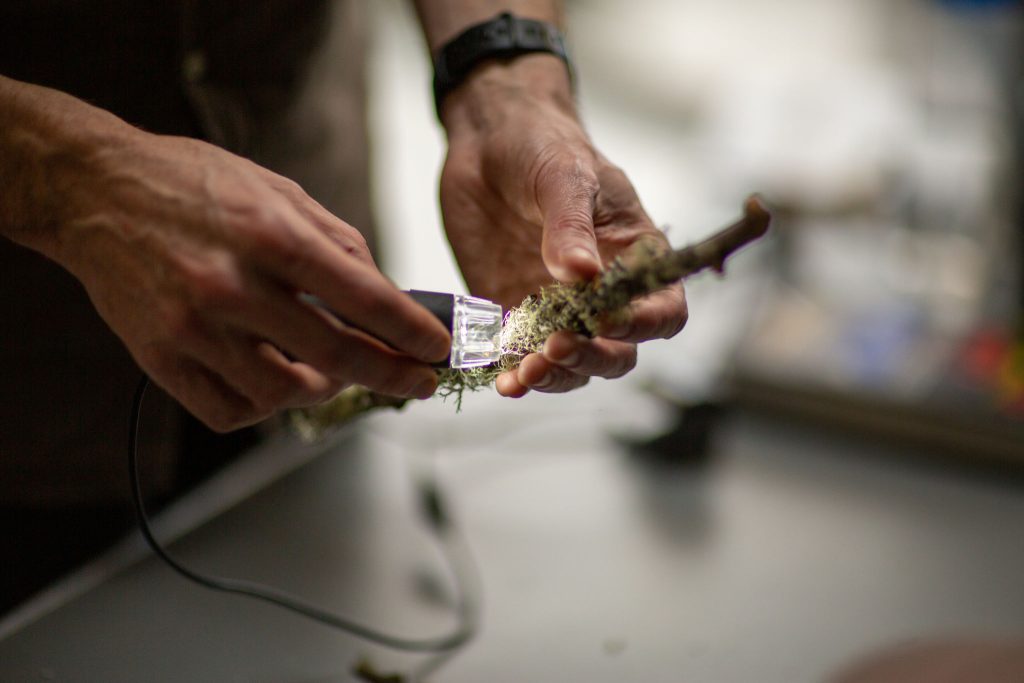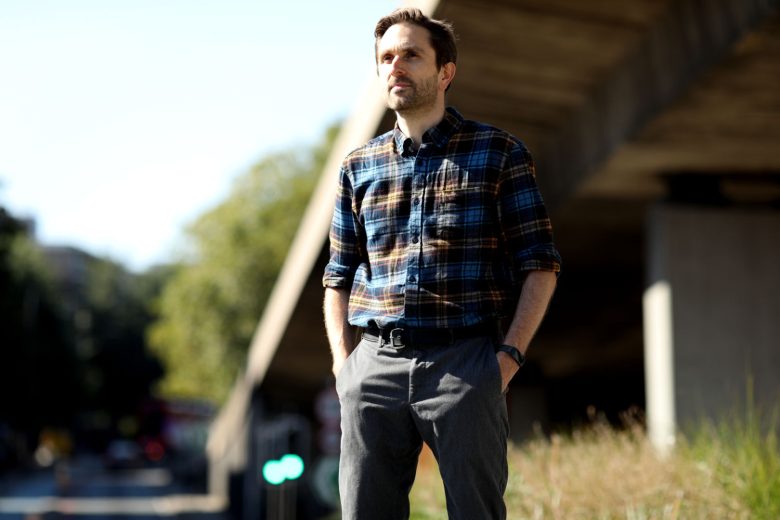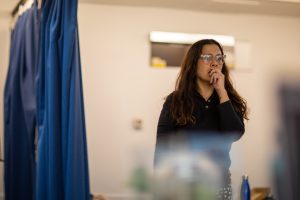This month’s spotlight is on DYSBIOSIS designer-director and director of Daedalus Theatre Company Paul Burgess, who conceived the project back in 2020 before recruiting a team of creative practitioners last year to delve deeper into social constructions of Nature using a queer and interdisciplinary lens.
Tell us about yourself and your creative practice.
I’m a set and costume designer by training and self-taught in video and interactive digital, which I use in both performance and visual art contexts. I teach on the side, mainly English as a second language, at my partner’s tutorial school, Angkriz, though I’ve also taught on theatre and theatre design courses at various universities. Both feed my creative practice by challenging me in different ways. I also have various voluntary roles, mainly in the area of sustainability. These also feed into my creative work, and include being the coordinator of the Society of British Theatre Designers’s working group on sustainability and a co-director of Ecostage. I’m also on the Environmental Responsibility Subcommittee at Queens Theatre, Hornchurch, where we’re working on DYSBIOSIS. For fun, I play the violin, most often with The Black Smock Band, which connects with the music and storytelling we do as part of our EAST project. It all adds up to one interconnected creative practice.
What does ‘dysbiosis’ mean to you?
I suggested this as a working title for the project, and it seems to have stuck, so I suppose I need to explain myself!
It came initially from I Contain Multitudes: The Microbes Within Us and a Grander View of Life by Ed Yong. Having defined dysbiosis as ‘breakdowns in communication between different species – host and symbiont – that live together, ‘ Yong goes on to say:
Our planet has entered the Anthropocene – a new geological epoch when humanity’s influence is causing global climate change, the loss of wild species, and a drastic decline in the richness of life. Microbes are not exempt. On coral reefs or in human guts, we are disrupting the relationships between microbes and their hosts, often pulling apart species that have been together for millions of years.
I had already been thinking about the way we use Nature to talk about society, often in ways that are divorced from the reality of the natural world, such as the notion of the body politic, or economic competitiveness being described as Darwinian, or the absurd claim that LGBTQ+ people are unnatural. But what if the metaphorical body politic is suffering from metaphorical dysbiosis?
Were any aspects of the project new to you and, if so, what did you expect coming in?
I’ve never worked with so many directors and writers! I don’t get to do many designer-director-led projects. When I do, I usually work with people who are primarily there as performers, even if many of them write and direct on other projects. We also have lots of creative contributions from local residents. I was a little nervous that we’d have too many proverbial cooks. But our core group has wonderful chemistry, and the work with residents is producing some fantastic stuff. I think we’re going to end up with far more material than we can use, but that’s a good problem to have!
How did you find doing a second week of R&D after some months have passed?
The first R&D week was all about getting a feel for the themes and working out how to collaborate. The sharing at the end was a great first step, but it was essentially a collage of lots of bits of writing with a simple framing device – a lecture going wrong – to hold it together. It was incredibly useful, however, because in the second R&D week, we hit the ground running, and it was an amazingly creative and fruitful experience.
In your own words, what is devised theatre? And how did it apply in this project?
I’d say it’s basically about creating the work as a company rather than having a writer create a script. More personally, I think it’s also about questioning the hierarchies normalised within theatre-making, with the writer and director sometimes having tremendous power over other people of equal talent.
I also think a designer-director can bring something unique to devised projects. I would say that, of course! But it’s an observation I’ve come to through over two decades of experience. My design process puts careful research and dramaturgical integrity ahead of spectacle. My goal is to find the ‘logic’ of the piece, which the director may or may not have already established, and then to create the right frame to hold and enable that. In devised work, finding the logic and its corresponding frame is the key to making a coherent piece of work and to creating a rehearsal room situation where people can experiment and pursue their own lines of enquiry. I could talk about this for hours, but if you want an example, A PLACE AT THE TABLE is where this connection between the design process and the kind of devising I wanted to do really clicked into place.
How did you find working collaboratively with creative practitioners from different disciplines?
I love it, especially when the roles are fluid. It creates a genuinely creative space. It’s not always easy. Sometimes, you need to draw a line because you have to respect people’s expertise. For example, I might suggest a sound idea that a composer knows won’t work. So it has to be managed carefully. But as long as you get the balance right, it’s great.
I’m currently doing an MSc in Green Building, and one of the fantastic things about that is being with lots of people from very different backgrounds. It made me realise how much time I spend with other people who work in the arts, and I’ve had some great conversations with people from backgrounds ranging from sheep farming to architectural technology. Interestingly, some of my devising experience has come in handy for course group work, as I know how to create a situation that’s conducive to collaboration and co-creation.
How have you found it working in the Outer East London/South Essex area?
I’m keen to anchor the work in the place where we’re making it. I’m from Harlow, in the west of Essex, and now live in the East End, where my Mum’s family lived for several generations after coming from Eastern Europe. So I feel right at home even though I’m not actually from either South Essex or Outer East London. There’s a kind of shared identity, formed from the movement of people out of the old East End to the suburbs and beyond. My dad is from Mersea Island on the Essex coast, which is a different kind of place in many ways, but I was vividly reminded of its landscapes when we visited Rainham Marshes.
What are you currently excited about creatively?
I’m pretty excited about how queerness is being brought to the fore in Daedalus’ work. We’ve been creeping around the edge of this for a while – there was definitely a queer aspect to MOBILE INCITEMENT, for example – but we’ve not previously made it central to our creative approach. In DYSBIOSIS, we’ve embraced it fully, and the lens of queer ecology has brought about so many fresh perspectives. These come partly from questioning the way we impose our heteronormative, binary-gendered assumptions onto Nature (which is, of course, full of non- and multi-binary queerness – especially fungi!). But they also come from thinking about how much more there is to Nature, in all its joyfulness and abundance, than just passing on genes. I’m trying to get my head around more abstract ideas too, like Timothy Morton’s claim that queer ecology is in opposition to individualism and Donna Haraway’s assertion that ‘We are compost, not posthuman; we inhabit the humusities, not the humanities. Philosophically and materially, I am a compostist, not a posthumanist.’ (Humus is soil produced by decayed matter, in case you don’t know.)
Can you recommend a book that relates to the themes in DYSBIOSIS?
I’ve been doing a lot of reading for this project, including Morton and Haraway. I have to admit I find them pretty difficult, although worth the effort. But here I want to mention the books I most enjoyed reading for research, and I’m sorry I can’t pick one! Ed Yong’s I Contain Multitudes: The Microbes Within Us and a Grander View of Life is a fantastic book on the world at microscopic level. Robin Wall Kimmerer’s Braiding Sweetgrass: Indigenous Wisdom, Scientific Knowledge and the Teachings of Plants explores her journey to connect Western science with indigenous knowledge and is a modern eco-classic. And be warned, Entangled Life: How Fungi Make Our Worlds, Change Our Minds and Shape Our Futures by Merlin Sheldrake may turn you into a fungi obsessive!
Top image: photo by Rehan Jamil



